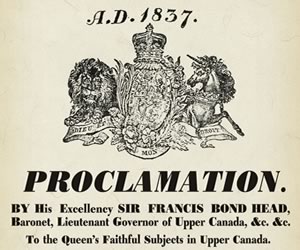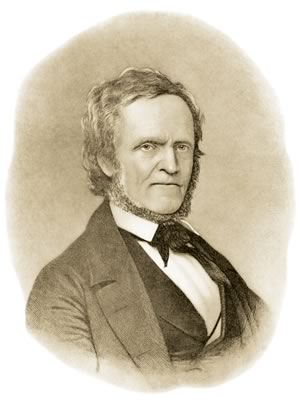The Rebellion of 1837: Not Just Montgomery’s Tavern
The rebellion in Upper Canada finally got British authorities to look into what was upsetting the colonies.
William Lyon Mackenzie’s brief foray in Toronto seems to get all the attention but the fighting in 1837-38 had a far wider base. Several hundred rebels led by Charles Duncombe were on their way from Brantford to join Mackenzie but dispersed near Hamilton when they learned of the defeat at Montgomery’s Tavern. Duncombe joined Mackenzie on Navy Island in the Niagara River where, with about 200 supporters, they proclaimed the Republic of Canada. In January, 1838 these new ‘republicans’ were pushed back to the U.S. where the majority dispersed. Duncombe went to California, Mackenzie to jail (briefly). The “Little Rebel” continued to agitate from the U.S. but his influence was very much diminished. Amnesty allowed him back into Canada in 1849.
Armed conflict in other areas continued well into 1838. In April, a group marched on the Hamilton jail to free six Reformers sentenced to hang for their part in Duncombe’s uprising, but a last minute reprieve ended that thrust. In July, a set of fierce skirmishes at Short Hills near St. Catharines made clear the rebellion was not yet over. And along the U.S./Canada border, a violently anti-British movement based in the U.S. known as ‘Hunter’s Lodges’ (they were not Fenians) saw opportunity in the Mackenzie-led uprising and began a year of border attacks. These reached a head in December, 1838 in two attempted invasions of Upper Canada, one known as the Battle of Windsor and the other, the Battle of the Windmill (near Prescott). In both battles the lodge members, almost all American supported by a few Canadian rebels, were soundly defeated. These were bloody affairs (e.g., Montgomery’s Tavern: 4 deaths; Battle of the Windmill: 70) but they brought the military phase of the Upper Canada Rebellion to an end.
Although the rebellion in Upper Canada finally got British authorities to look into what was upsetting the colonies (they were far more frightened by the simultaneous and quite larger rebellion in Lower Canada) change and democracy as we know it came very slowly. Not so for the punishment of defeated rebels. About 100 participants judged key to the uprising were transported to the penal colony on Van Dieman’s Land (Tasmania). Others were hanged for treason, among them seventeen of the prisoners captured at the Battle of the Windmill. Perhaps the best known rebels to go to the gallows were two of Mackenzie’s lieutenants, Samuel Lount, a blacksmith from Holland Landing and Peter Matthews, a farmer from Pickering. Both were prominent and widely respected citizens of Upper Canada and their sentence generated a petition for mercy signed by thousands but the British colonial authorities were determined to make examples of the two. They were hanged back to back in Toronto, on April 12, 1838. (Years later, Peter Matthews’ sister, Phoebe (Youmans) became a resident of Orangeville; she is buried in Forest Lawn cemetery.)
Samuel Lount the movie Clip 5 – The Rebellion of 1837 begins – Montgomery’s Tavern Dec 4-1837
Related Stories

How William Lyon Mackenzie Escaped Through Caledon …or Not!
Nov 17, 2012 | | Historic HillsThey were smuggled food by a local farmer’s wife who, knowing she was being watched, would tie packages of food to her crinolines and go for a walk.








This was our MacDonald ancestors who lived near the MacDonald cemetery on Creditview Road. They had come to Canada from Scotland in 1820, in a large group with our Kirkwoods as well.
Lois Kirkwood Osborne on Dec 9, 2020 at 8:41 am |